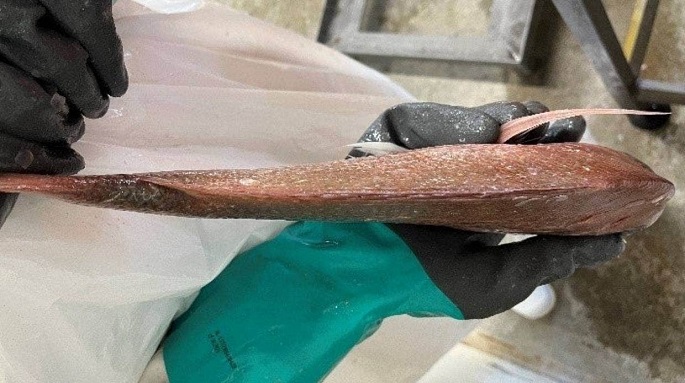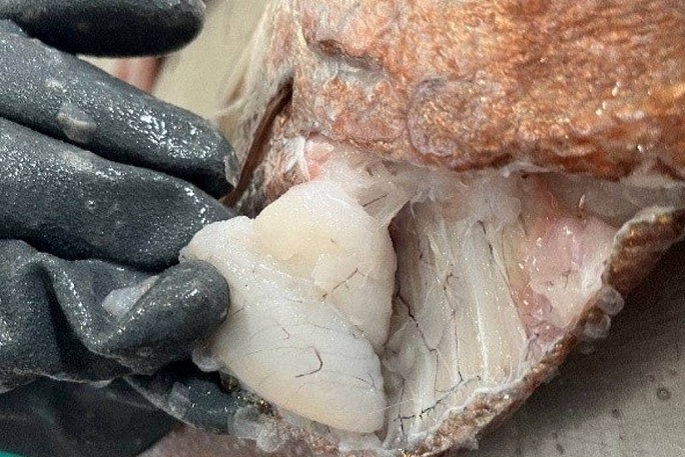An in-depth scientific report has found a mix of complex climate factors are likely causing Milky White Flesh Syndrome, says Fisheries New Zealand.
Fisheries New Zealand’s director science & information, Simon Lawrence, says snapper with the condition appear to be skinny and have mushy, white flesh rather than their usual translucent, firm flesh, and are malnourished.
"Early and ongoing tests ruled out exotic disease and food safety issues, meaning that fish with the syndrome are still safe for people to eat if they choose to," says Simon.
"The evidence suggests a complex interplay between factors, including extended La Niña weather patterns and warmer waters causing lower production of the phytoplankton and zooplankton that provide important food sources at the bottom of the food chain.
"This is a complex issue, and is more likely to be due to the effect of recent weather patterns and natural changes in fish biology throughout the seasons. Prevalence of the syndrome appears to be declining which supports these theories.
"Warmer ocean temperatures may also be affecting snapper metabolism, meaning they need to use more energy and require more food."
Simon says the report found that a lack of food was the likely cause of the syndrome, but there was no evidence to suggest that fishing was the cause of that.
"Overall, we’ve been seeing more snapper in the Hauraki Gulf for some time. The fishery is abundant, with plenty of younger fish entering the stock, all competing for food.
"Commercial fishing does not affect the main food sources of snapper.
"They are opportunistic feeders and are unfussy about what they will eat."
Simon says the areas in the Gulf where bottom trawling was permitted did not correlate with the areas where the syndrome was most prevalent.
The National Institute of Water and Atmospheric Research (NIWA) undertook research on behalf of Fisheries New Zealand and collected a range of data, including information from commercial and recreational fishers about affected snapper and where it had been caught.
The syndrome has been most prevalent throughout the inner Hauraki Gulf, near Auckland, and around Doubtless Bay near Northland.
 Fish with milky white flesh syndrome were found to be very skinny and have nutritional deficiencies including liver atrophy and tissue breakdown. Photo: Rikki Taylor | NIWA.
Fish with milky white flesh syndrome were found to be very skinny and have nutritional deficiencies including liver atrophy and tissue breakdown. Photo: Rikki Taylor | NIWA.
Researchers considered data gathered from fishers together with environmental information, such as sea surface temperature, to determine if any changes had occurred in the period before fish with the syndrome were seen.
"We know that individual growth rates of all snapper around New Zealand have declined over the last 15 years as snapper abundance has increased, which could be explained by the mix of factors at play."
Fisheries New Zealand has received recent reports about snapper with a few similar symptoms on the North Island’s west coast. Some initial tests have been undertaken and Fisheries New Zealand continues to investigate, but there are no biosecurity concerns.
"The report underlines this complexity and its insights will be used in future fisheries assessments."



3 comments
Yeah, right...
Posted on 27-06-2024 12:18 | By morepork
It's not our fault. We're not responsible. All we did was raise the acidity of the oceans, remove countless tonnes of fish stocks, destroy a fragile eco system with unbridled bottom trawling, and now we are surprised when the schnapper are starving and their flesh is no longer attractive to eat. Does anyone seriously think that, if there were NO Human Beings on the planet, schnapper would be in this situation? Humans have dominion over all the other species on the planet, but that power should bring responsibility, and, instead, it gets corrupted by greed and the pursuit of easy ways to exploit the resources.
The Master
Posted on 27-06-2024 16:42 | By Ian Stevenson
@ Morepork
No, none of that.. the stock standard answer it's all caused by climate change... blah blah... a thing that has always existed from the beginning 4.6 billion years ago... has always been so and will always be so.
Snapper would be in the exact same position as now, at anytime past of future when the water temperature rises e.g. the reality of La Nina/El Nino for starters...
Regardless, temperature and CO2 have risen and fallen (often in opposite direction, more often than the same direction) multiple times more than the last 150 odd years. Yet these silly notions run a-muck rampant spending on 100% waste-fully silliness.
Sadly the propagators of the fake CO2 thing are being paid to say, repeat and exaggerate it and some.
@Ian Stevenson
Posted on 29-06-2024 14:16 | By morepork
I am fully aware of the pros and cons of the Climate change arguments and have had some involvement in processing data from various points on it. If you read my post again you will see I never mentioned climate change. My answer was neither "stock standard" nor "all caused by climate change". I stated what I think, based on my own observations and conclusions; I very rarely follow any particular "party line".
I agree with you that schnapper would have been affected by previous warming in exactly the same way, if their current situation WAS caused by temperature rise.
Leave a Comment
You must be logged in to make a comment.